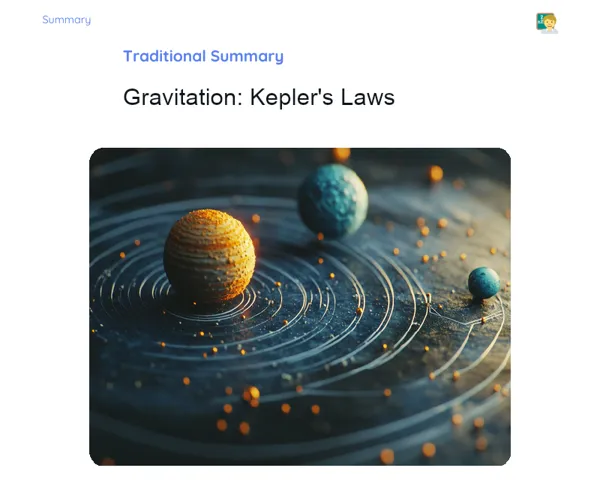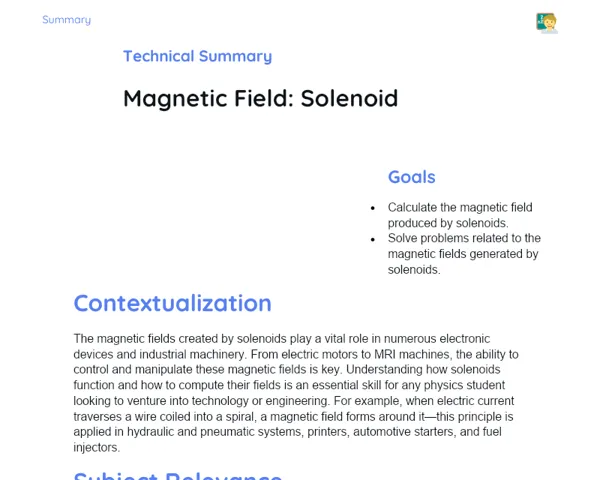Summary Tradisional | Work: Gravitational Potential Energy
Contextualization
Energy is one of the most fundamental concepts in physics, existing in various forms and is essential for the functioning of nearly everything around us. One particular type of energy that we will discuss is gravitational potential energy, which is directly tied to the location of an object in a gravitational field, like that of the Earth. Understanding this form of energy is crucial for grasping many natural and technological phenomena, such as falling objects and how hydroelectric power plants operate.
Gravitational potential energy is the energy stored in an object because of its height compared to a reference point, typically the ground. When an object is raised, it gathers potential energy, which can be transformed into other energy forms, like kinetic energy, when the object is allowed to fall. This concept applies to our daily lives, from thrilling rides at amusement parks, like roller coasters, to energy generation systems, such as hydroelectric dams.
To Remember!
Definition of Gravitational Potential Energy
Gravitational potential energy is the energy an object holds because of its position in a gravitational field. This energy depends directly on the object's height in relation to a reference point, usually the ground, and its mass. When an object is raised, it accumulates gravitational potential energy, which can convert into other forms of energy, such as kinetic energy when the object falls. The formula to calculate gravitational potential energy is Epg = mgh, where 'm' is the mass of the object, 'g' is the acceleration due to gravity (approximately 9.8 m/s² on Earth), and 'h' is the height above the reference point.
Gravitational potential energy is a form of mechanical energy observable in many natural events and technological applications. For instance, when you hold a book above the ground and let it go, the gravitational potential energy of the book transforms into kinetic energy as it falls. This concept is fundamental in understanding energy transformation and conservation in physical systems.
In larger systems, like hydroelectric power plants, the gravitational potential energy of water kept in large reservoirs turns into kinetic energy as the water flows down, and then this kinetic energy is converted into electrical energy by turbines and generators. This is a clear illustration of how gravitational potential energy is practically utilized to generate usable energy.
-
Gravitational potential energy arises from the position of an object within a gravitational field.
-
The formula to calculate gravitational potential energy is Epg = mgh.
-
It is a type of mechanical energy that can transform into various other energy forms, such as kinetic energy.
Formula for Gravitational Potential Energy
The formula for gravitational potential energy is Epg = mgh, where 'Epg' refers to gravitational potential energy, 'm' is the mass of the object, 'g' represents the acceleration due to gravity, and 'h' signifies the height of the object compared to a reference point. This formula derives from the work needed to lift an object against the gravitational force.
To effectively use this formula, it's crucial to grasp each of its components. Mass (m) indicates the quantity of matter within an object, typically measured in kilograms (kg). The acceleration due to gravity (g) is a constant value, about 9.8 m/s² at the surface of the Earth. Height (h) accounts for the vertical distance of the object from the reference point, measured in meters (m).
By applying this formula, we can compute the gravitational potential energy an object possesses at a specific height. For example, for an object weighing 5 kg raised to a height of 2 meters, the gravitational potential energy would be Epg = 5 kg * 9.8 m/s² * 2 m = 98 Joules.
-
The formula for gravitational potential energy is Epg = mgh.
-
The components involved in this formula are mass (m), gravity (g), and height (h).
-
The unit for gravitational potential energy in the International System is the Joule (J).
Transformation of Potential Energy into Kinetic Energy
Gravitational potential energy can change into kinetic energy as an object falls. Kinetic energy pertains to the energy an object has because of its motion, and its formula is Ec = 1/2 mv², where 'Ec' is the kinetic energy, 'm' is the object's mass, and 'v' is the object's velocity.
When an object gets released from a certain height, the gravitational potential energy it holds because of its position gradually turns into kinetic energy as it speeds towards the ground. This transformation continues until all the gravitational potential energy is converted into kinetic energy, assuming no energy loss occurs due to external forces like air resistance.
For instance, if an object with a mass of 2 kg is dropped from a height of 10 meters, the initial gravitational potential energy can be computed as Epg = mgh = 2 kg * 9.8 m/s² * 10 m = 196 Joules. As the object descends, this energy is transformed into kinetic energy, and upon hitting the ground, all the energy is in the form of kinetic energy.
-
Gravitational potential energy converts into kinetic energy.
-
The formula for kinetic energy is Ec = 1/2 mv².
-
During the fall, gravitational potential energy transitions into kinetic energy.
Conservation of Energy
The principle of conservation of energy states that the total energy within an isolated system remains unchanged. This means that energy cannot be created or destroyed; it can only change forms. This principle is a cornerstone in various branches of physics and holds particular significance in analyzing mechanical systems.
In the context of gravitational potential and kinetic energy, conservation of energy implies that the total of these energies within an isolated system does not alter. For example, when an object descends, its gravitational potential energy drops while its kinetic energy rises, but the sum of the two energies remains constant.
We can see this principle at work in various practical situations. For example, in a roller coaster, the gravitational potential energy of the cart at the peak of a hill turns into kinetic energy as it goes downward, and the reverse occurs when it climbs back up. Similarly, in a pendulum, the gravitational potential energy at the peak of the swing changes into kinetic energy as the pendulum descends to its lowest point.
-
The conservation of energy states that the total energy within an isolated system stays constant.
-
Energy can transform from one form to another but cannot simply be created or destroyed.
-
The total of gravitational potential energy and kinetic energy in an isolated system remains constant.
Key Terms
-
Gravitational Potential Energy: Energy stored in an object due to its position within a gravitational field.
-
Epg = mgh: Formula to calculate gravitational potential energy.
-
Kinetic Energy: The energy an object holds due to its motion.
-
Ec = 1/2 mv²: Formula to calculate kinetic energy.
-
Conservation of Energy: Principle stating that the total energy in an isolated system remains constant.
Important Conclusions
In this lesson, we delved into the concept of gravitational potential energy and its significance in physics and various applications. We explored the formula Epg = mgh, which enables us to compute the gravitational potential energy of an object based on its mass, height, and the gravitational acceleration. We also examined how this energy can convert into kinetic energy, particularly in scenarios where an object is in free fall.
The conservation of energy was another vital topic covered, emphasizing that the total energy in an isolated system stays constant and merely transforms from one form to another. This principle is essential for comprehending the dynamics of mechanical systems, such as roller coasters and pendulums, where gravitational potential energy shifts into kinetic energy and vice versa.
Grasping gravitational potential energy is crucial for a wide array of scientific and technological fields, from constructing structures and transportation systems to generating energy in hydroelectric power stations. This understanding not only enhances their grasp of natural occurrences but also equips students with the skills to apply these concepts in real-world contexts and future careers in engineering and physics.
Study Tips
-
Review practical examples covered in class, like falling objects and roller coaster mechanics, to solidify understanding of gravitational potential and kinetic energy concepts.
-
Practice solving problems using the formulas Epg = mgh and Ec = 1/2 mv², focusing on energy transformations and conservation in different situations.
-
Explore additional resources, such as informative videos and online simulations, demonstrating the conversion of gravitational potential energy into kinetic energy in various scenarios.



